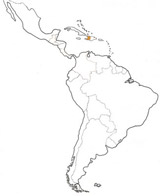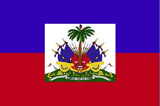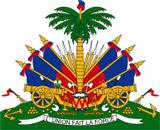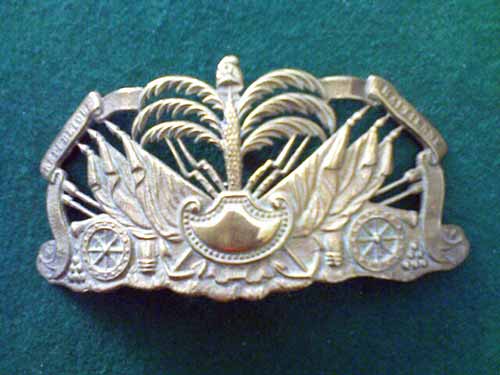Entre son indépendance en 1803 et la fin du XIXème siècle, l’armée de la petite République francophone caraïbe n’utilise pas de casques. Le climat tropical et le désordre ambiant rendent une telle adoption aléatoire.
Au début du XXème siècle, sous l’influence de la mode parisienne, la cavalerie haïtienne se dote de casques de cuirassiers de fabrication française. Ceux-ci se distinguent des modèles français par une plaque frontale aux armes du pays.
Sur la carte postale ci-dessous, datant du début du XXème siècle, on distingue plusieurs cuirassiers du Régiment de cavalerie de la Garde, dotés de tels casques. L’usage de ces casques est interrompu en 19161.
Après une période de grand désordre, les États-Unis prirent en 1915 le contrôle du pays de Toussait Louverture où ils restèrent jusqu’en 1934. Jusqu’à la Seconde Guerre mondiale, les soldats de la petite armée insulaire ne portaient pas de casque, la principale activité de ces militaires étant de faire et défaire les Présidents de la République.
Au début du XXème siècle, sous l’influence de la mode parisienne, la cavalerie haïtienne se dote de casques de cuirassiers de fabrication française. Ceux-ci se distinguent des modèles français par une plaque frontale aux armes du pays.
Sur la carte postale ci-dessous, datant du début du XXème siècle, on distingue plusieurs cuirassiers du Régiment de cavalerie de la Garde, dotés de tels casques. L’usage de ces casques est interrompu en 19161.
Après une période de grand désordre, les États-Unis prirent en 1915 le contrôle du pays de Toussait Louverture où ils restèrent jusqu’en 1934. Jusqu’à la Seconde Guerre mondiale, les soldats de la petite armée insulaire ne portaient pas de casque, la principale activité de ces militaires étant de faire et défaire les Présidents de la République.
HAITI
The Republic of Haiti, independent since 1803, is one of the oldest states in Latin America. Unfortunately, it has also, since its creation, remained the poorest. Nothing suggests an improvement in that sad characterization.
For its first hundred years Haiti maintained a small military force of some 6000 men, employed mainly for political purposes and seriously lacking in professionalism.
Military equipment and uniforms were European in design (particularly French as fitting a former French colony), but considering the country’s limited resources and the oppressive climate, no helmets were worn.
In 1915 the US occupied the country. In order to help fight a nationalist (Caco) guerrilla movement, a paramilitary force, the Gendarmerie d’Haïti, was created. Members of this organization were supplied with surplus US Marine uniforms, but only caps and hats were issued.
In 1934, the US forces departed Haiti. A mounted military unit, somewhat similar to the French Garde Républicaine, was established. These troops wore French-style uniforms with cuirassier helmets, sporting the national coat of arms on the front. This unit was short-lived.
During the Second World War large quantities of US military equipment (including light tanks) were delivered to Port aux Princes, but only in 1954 did what could be called a real army emerge, numbering 4500 soldiers.
In 1957, François Duvalier, a country physician, came to power, quickly seizing dictatorial authority. He neutralized the existing army (seen as the private tool of the main landowners of the country) and created a parallel paramilitary force – les Volontaires de la Sécurité Nationale, commonly known as Tonton Macoutes.
Initially, neither the army nor the Tontons Macoutes wore helmets. After the Second World War some US helmets began to appear, but were used mostly during riots. In the late 1950s, Colonel Robert Debs Heinl, Jr., under the auspices of the US Training Mission, undertook once more to restructure the army. It was renamed L’Armée Haitienne in 1963. For the first time military helmets became standard issue with the introduction of a black plastic M1 ballistic clone.
But by 1996 the organization and effectiveness of the Haitian National Army had deteriorated so manifestly that the National Assembly saw no alternative but to order that the Army be disbanded.
Since that date, with the help of US military advisers, a Police Nationale d’Haiti, performs police duties as well as serving in the role of a national army. These individuals wear US-made PASGT helmets. Tank crews use various models of American helmets.
In 2012 President Martelli mentioned a project to recreate a professional army in Haiti.
The Republic of Haiti, independent since 1803, is one of the oldest states in Latin America. Unfortunately, it has also, since its creation, remained the poorest. Nothing suggests an improvement in that sad characterization.
For its first hundred years Haiti maintained a small military force of some 6000 men, employed mainly for political purposes and seriously lacking in professionalism.
Military equipment and uniforms were European in design (particularly French as fitting a former French colony), but considering the country’s limited resources and the oppressive climate, no helmets were worn.
In 1915 the US occupied the country. In order to help fight a nationalist (Caco) guerrilla movement, a paramilitary force, the Gendarmerie d’Haïti, was created. Members of this organization were supplied with surplus US Marine uniforms, but only caps and hats were issued.
In 1934, the US forces departed Haiti. A mounted military unit, somewhat similar to the French Garde Républicaine, was established. These troops wore French-style uniforms with cuirassier helmets, sporting the national coat of arms on the front. This unit was short-lived.
During the Second World War large quantities of US military equipment (including light tanks) were delivered to Port aux Princes, but only in 1954 did what could be called a real army emerge, numbering 4500 soldiers.
In 1957, François Duvalier, a country physician, came to power, quickly seizing dictatorial authority. He neutralized the existing army (seen as the private tool of the main landowners of the country) and created a parallel paramilitary force – les Volontaires de la Sécurité Nationale, commonly known as Tonton Macoutes.
Initially, neither the army nor the Tontons Macoutes wore helmets. After the Second World War some US helmets began to appear, but were used mostly during riots. In the late 1950s, Colonel Robert Debs Heinl, Jr., under the auspices of the US Training Mission, undertook once more to restructure the army. It was renamed L’Armée Haitienne in 1963. For the first time military helmets became standard issue with the introduction of a black plastic M1 ballistic clone.
But by 1996 the organization and effectiveness of the Haitian National Army had deteriorated so manifestly that the National Assembly saw no alternative but to order that the Army be disbanded.
Since that date, with the help of US military advisers, a Police Nationale d’Haiti, performs police duties as well as serving in the role of a national army. These individuals wear US-made PASGT helmets. Tank crews use various models of American helmets.
In 2012 President Martelli mentioned a project to recreate a professional army in Haiti.




